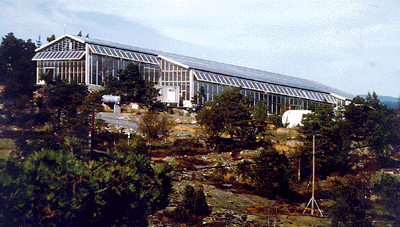

![]()

The CLIMEX project was developed at Risdalsheia following the cessation of a similar experiment, RAIN which ran from 1983-94.
CLIMEX is a unique integrated, whole-ecosystem research project, designed to monitor the response of entire catchments to increased CO2 and temperature. This experiment is 100 times larger than previous whole ecosystem experiments of this kind. CO2 and temperature are manipulated within the confines of a glasshouse so that the changes in mature forest growth and nutrient status can be measured insitu. The CLIMEX project allows the quantification of links between terrestrial aquatic ecosystems, providing data and information on the effect of climate change on natural forests, terrestrial ecosystems and water resources. These field observations form a base to improve and develop biogeochemical models so to evaluate the impact of future scenarios of climatic change. It is anticipated that the CLIMEX project will continue until 1998 so to link dynamic process studies of vegetation, soils, and soil fauna with large scale catchment measurements of hydrology, nutrients and gas fluxes. The results from this CLIMEX project contribute to the requirements of European policy for natural resource management and for determining national pollutant target emissions. The CLIMEX project also contributes directly to the IGBP/GCTE programme on the impact of global change on natural ecosystems.
The project involves five catchments and employs multiple treatments and controls.
| Catchment | Area (m2) | Enclosure | Rain Quality | Climate treatment | Start of monitoring |
|---|---|---|---|---|---|
| KIM | 690 | roof | clean | CO2 + air warming | June 1983 |
| (control) | 170 | roof | clean | none | June 1993 |
| EGIL | 320 | roof | acid | soil warming | June 1983 |
| (control) | 80 | roof | acid | none | June 1993 |
| ROLF | 220 | no roof | acid | none | June 1983 |
| METTE | 650 | no roof | acid | none | June 1993 |
| CECILE | 380 | no roof | acid | none | June 1993 |
The objectives and hypotheses of CLIMEX are outlined below. Briefly they are, by enriching CO2 and elevating temperature to boreal forest catchments:
Key responses which require quantification are the rates at which the system responds, the potential for achieving a new "equilibrium" condition, and the feed back responses which might operate to limit the ecosystem response in the longer term.